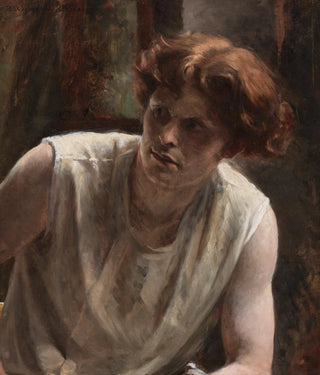Painting Study of a Female Model - Bertha Wegmann | Art print


View from behind

Frame (optional)
Reproduction Study of a Female Model - Bertha Wegmann – Captivating Introduction
In the vast panorama of art history, few works manage to capture the very essence of humanity. "Study of a Female Model" by Bertha Wegmann is a perfect example. This piece, imbued with delicacy and depth, immerses us in the intimacy of a frozen moment, where beauty and vulnerability meet. The Danish artist, active at the end of the 19th century, succeeds in transcending mere representation to offer a glimpse into the human soul. Through this artwork, she invites us to contemplate not only the form of the female body but also the emotions it conveys. Light, texture, and meticulous details come together to create an atmosphere that is both soothing and unsettling, prompting us to explore the nuances of the human condition.
Style and uniqueness of the work
Bertha Wegmann's style is distinguished by its finesse and ability to capture moments of truth. In "Study of a Female Model," each brushstroke seems imbued with rare sensitivity. Wegmann uses a subtle color palette, where soft tones and delicate shadows blend harmoniously. The model's posture, both natural and posed, evokes a serenity that invites contemplation. This choice of representation reflects a modernist approach that moves away from the academic conventions of her time. Wegmann manages to breathe life into her model, transforming a simple study into a true work of art. The composition, balanced and thoughtful, highlights the beauty of the female body while maintaining a certain modesty. Thus, the work is not limited to a simple study of form but rises to a reflection on beauty and identity.
The artist and her influence
Bertha Wegmann is a prominent figure in Danish art, but her influence extends beyond the borders of her homeland. Trained at the Royal Danish Academy of Fine Arts in Copenhagen, she managed to establish herself in an artistic environment dominated by men. Her work has been widely recognized, both nationally and internationally, and she played a crucial role in the emergence of female art in the 19th century

Matte finish

View from behind

Frame (optional)
Reproduction Study of a Female Model - Bertha Wegmann – Captivating Introduction
In the vast panorama of art history, few works manage to capture the very essence of humanity. "Study of a Female Model" by Bertha Wegmann is a perfect example. This piece, imbued with delicacy and depth, immerses us in the intimacy of a frozen moment, where beauty and vulnerability meet. The Danish artist, active at the end of the 19th century, succeeds in transcending mere representation to offer a glimpse into the human soul. Through this artwork, she invites us to contemplate not only the form of the female body but also the emotions it conveys. Light, texture, and meticulous details come together to create an atmosphere that is both soothing and unsettling, prompting us to explore the nuances of the human condition.
Style and uniqueness of the work
Bertha Wegmann's style is distinguished by its finesse and ability to capture moments of truth. In "Study of a Female Model," each brushstroke seems imbued with rare sensitivity. Wegmann uses a subtle color palette, where soft tones and delicate shadows blend harmoniously. The model's posture, both natural and posed, evokes a serenity that invites contemplation. This choice of representation reflects a modernist approach that moves away from the academic conventions of her time. Wegmann manages to breathe life into her model, transforming a simple study into a true work of art. The composition, balanced and thoughtful, highlights the beauty of the female body while maintaining a certain modesty. Thus, the work is not limited to a simple study of form but rises to a reflection on beauty and identity.
The artist and her influence
Bertha Wegmann is a prominent figure in Danish art, but her influence extends beyond the borders of her homeland. Trained at the Royal Danish Academy of Fine Arts in Copenhagen, she managed to establish herself in an artistic environment dominated by men. Her work has been widely recognized, both nationally and internationally, and she played a crucial role in the emergence of female art in the 19th century
12,34 €






